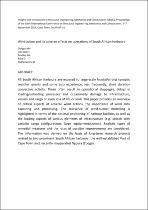JavaScript is disabled for your browser. Some features of this site may not work without it.
- ResearchSpace
- →
- Research Publications/Outputs
- →
- Conference Publications
- →
- View Item
| dc.contributor.author |
Goliger, Adam

|
|
| dc.contributor.author |
Van Wyk, Ters

|
|
| dc.contributor.author |
Bradley, RA

|
|
| dc.contributor.author |
Bilse, D

|
|
| dc.contributor.author |
Ruthenavelu, M

|
|
| dc.date.accessioned | 2017-07-28T09:04:28Z | |
| dc.date.available | 2017-07-28T09:04:28Z | |
| dc.date.issued | 2016-08 | |
| dc.identifier.citation | Goliger, A., Van Wyk, T., Bradley, R.A. et al. 2016. Wind action and its adverse effects on operations of South African harbours. Insights and Innovations in Structural Engineering, Mechanics and Computation (SEMC): Proceedings of the Sixth International Conference on Structural Engineering, Mechanics and Computation, 5-7 September 2016, Cape Town, South Africa, p. 675-680. doi: 10.1201/9781315641645-111 | en_US |
| dc.identifier.isbn | 978-1-138-02927-9 | |
| dc.identifier.uri | http://www.crcnetbase.com/doi/10.1201/9781315641645-111 | |
| dc.identifier.uri | doi: 10.1201/9781315641645-111 | |
| dc.identifier.uri | http://hdl.handle.net/10204/9363 | |
| dc.description | Coopyright: 2016 Taylor & Francis Group. Due to copyright restrictions, the attached PDF file only contains the abstract of the full text item. For access to the full text item, kindly consult the publisher's website. | en_US |
| dc.description.abstract | All South African harbours are exposed to large-scale frontal/strong synoptic weather events and some also experience, less frequently, short duration convective activity. These often result in operational stoppages, delays in loading/unloading processes and occasionally damage to infrastructure, vessels and cargo or even loss of life or limb. This paper provides an overview of critical aspects of adverse wind actions, the importance of wind data capturing and processing. The relevance of wind-tunnel modelling is highlighted in terms of the optimal positioning of harbour facilities as well as the loading aspects of various elements of infrastructure (e.g. vessels with variable cargo configurations, large equipment/cranes). Realistic types of remedial measures and the rates of possible improvements are considered. The information was derived on the basis of long-term research projects related to two prominent South African harbours: the well-established Port of Cape Town and, recently inaugurated Ngqura (Coega). | en_US |
| dc.language.iso | en | en_US |
| dc.publisher | CRCnetBase, Taylor & Francis | en_US |
| dc.subject | South African harbours | en_US |
| dc.subject | Synoptic weather events | en_US |
| dc.subject | Adverse wind actions | en_US |
| dc.subject | Port of Cape Town | en_US |
| dc.subject | Port of Ngqura (Coega) | en_US |
| dc.title | Wind action and its adverse effects on operations of South African harbours | en_US |
| dc.type | Conference Presentation | en_US |
| dc.identifier.apacitation | Goliger, A., Van Wyk, T., Bradley, R., Bilse, D., & Ruthenavelu, M. (2016). Wind action and its adverse effects on operations of South African harbours. CRCnetBase, Taylor & Francis. http://hdl.handle.net/10204/9363 | en_ZA |
| dc.identifier.chicagocitation | Goliger, Adam, Ters Van Wyk, RA Bradley, D Bilse, and M Ruthenavelu. "Wind action and its adverse effects on operations of South African harbours." (2016): http://hdl.handle.net/10204/9363 | en_ZA |
| dc.identifier.vancouvercitation | Goliger A, Van Wyk T, Bradley R, Bilse D, Ruthenavelu M, Wind action and its adverse effects on operations of South African harbours; CRCnetBase, Taylor & Francis; 2016. http://hdl.handle.net/10204/9363 . | en_ZA |
| dc.identifier.ris | TY - Conference Presentation AU - Goliger, Adam AU - Van Wyk, Ters AU - Bradley, RA AU - Bilse, D AU - Ruthenavelu, M AB - All South African harbours are exposed to large-scale frontal/strong synoptic weather events and some also experience, less frequently, short duration convective activity. These often result in operational stoppages, delays in loading/unloading processes and occasionally damage to infrastructure, vessels and cargo or even loss of life or limb. This paper provides an overview of critical aspects of adverse wind actions, the importance of wind data capturing and processing. The relevance of wind-tunnel modelling is highlighted in terms of the optimal positioning of harbour facilities as well as the loading aspects of various elements of infrastructure (e.g. vessels with variable cargo configurations, large equipment/cranes). Realistic types of remedial measures and the rates of possible improvements are considered. The information was derived on the basis of long-term research projects related to two prominent South African harbours: the well-established Port of Cape Town and, recently inaugurated Ngqura (Coega). DA - 2016-08 DB - ResearchSpace DP - CSIR KW - South African harbours KW - Synoptic weather events KW - Adverse wind actions KW - Port of Cape Town KW - Port of Ngqura (Coega) LK - https://researchspace.csir.co.za PY - 2016 SM - 978-1-138-02927-9 T1 - Wind action and its adverse effects on operations of South African harbours TI - Wind action and its adverse effects on operations of South African harbours UR - http://hdl.handle.net/10204/9363 ER - | en_ZA |






